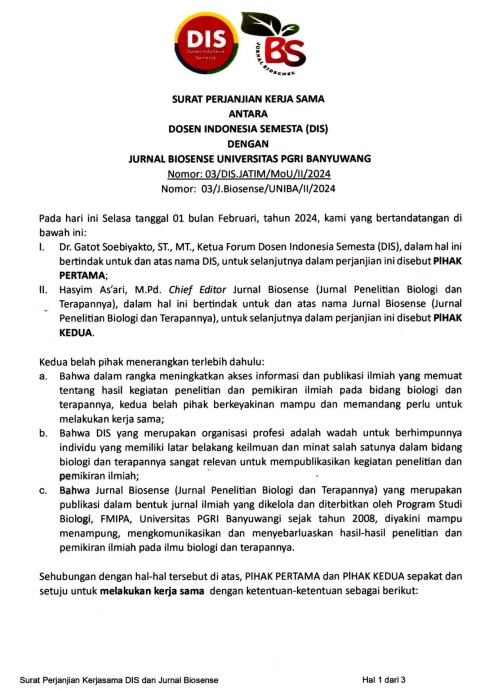PERPANJANG DAYA SIMPAN BUAH TOMAT (SOLANUM LYCOPERSICUM) DENGAN EDIBLE COATING BERBAHAN DASAR PATI SINGKONG (MANIHOT UTTILISIMA)
PERPANJANG DAYA SIMPAN BUAH TOMAT (SOLANUM LYCOPERSICUM) DENGAN EDIBLE COATING BERBAHAN DASAR PATI SINGKONG (MANIHOT UTTILISIMA)
DOI:
https://doi.org/10.36526/biosense.v5i01.1967Keywords:
buah tomat, daya simpan, edible coating, pati singkongAbstract
Tomato fruit that is harvested will retain its freshness for a maximum of 6-7 days, because during that time the fruit is still able to maintain metabolic activity by recycling the food reserves stored in the fruit. However, if it is more than that time, the quality of the fruit begins to decline, such as the fruit begins to wrinkle, is damaged and can even experience decay. Handling must be done immediately when the fruit is just harvested or before the fruit is 1 week old, so that the condition of the fruit can still be maintained. One way is to use an edible coating made from cassava starch. The content of tannins in cassava starch is able to kill bacteria. This study aims to test edible coatings made from cassava starch with different concentrations on the shelf life of fresh tomatoes. The research design used was descriptive quantitative in the form of a completely randomized design (CRD) with 3 different concentrations, namely 0%, 3%, and 6%. Each treatment consisted of 5 replications. Thus, 15 experimental units were obtained. The tomatoes used are tomatoes purchased at the market and are 7 days old after harvest. Soaking taro starch edible coating was carried out for 24 hours and stored in an open space at room temperature. Parameters observed were weight loss and tomato fruit morphology. The results showed that the use of edible coating with cassava starch as the base material had a significant effect (P<0.05) on the weight loss of tomatoes. The most optimal concentration of edible coating is 6% because it has a longer resistance level in extending the shelf life of tomatoes. Likewise, the morphology of tomatoes is better at a concentration of 6%. Fresh tomatoes stored with edible coating treatment made from cassava starch with a concentration of 6% were able to last up to 14 days at room temperature compared to other concentrations.
References
Bilbao-Sainz, C., Sinrod, A. J. G., Dao, L., Takeoka, G., Williams, T., Wood, D., Chiou, B. Sen, Bridges, D. F., Wu, V. C. H., Lyu, C., Powell-Palm, M. J., Rubinsky, B., & McHugh, T. (2021). Preservation of grape tomato by isochoric freezing. Food Research International, 143(February), 110228. https://doi.org/10.1016/j.foodres.2021.110228
Christina Winarti, Miskiyah, dan W. (2012). TEKNOLOGI PRODUKSI DAN APLIKASI PENGEMAS EDIBLE ANTIMIKROBA. Jurnal Penelitian Dan Pengembangan Pertanian, 31(3), 85–93.
Gunaeni, N., & Purwati, E. (2013). Uji Ketahanan terhadap Tomato Yellow Leaf Curl Virus pada Beberapa Galur Tomat. Jurnal Hortikultura, 23(1), 65. https://doi.org/10.21082/jhort.v23n1.2013.p65-71
Ketty Suketi, Roedhy Poerwanto, Sriani Sujiprihati, W. D. W. (2010). Studi Karakter Mutu Buah Pepaya IPB. J. Hort. Indonesia, 1(1), 17–26.
Laily, N. (2013). Pengaruh jenis pati sebagai bahan dasar edible coating dan suhu penyimpanan terhadap kualitas stroberi (Fragaria x ananassa) var.rosa linda [Universitas Islam Negeri Maulana Malik Ibrahim.]. http://etheses.uin-malang.ac.id/489/
Miskiyah, Widianingrum, C. W. (2018). Edible Coating Berbasis Pati Sagu dan Vitamin C Untuk Meningkatkan Daya Simpan Paprika Merah (Capsicum Annum Var. Athena). In Jurnal Penelitian Pascapanen Pertanian (Vol. 8, Issue 1, pp. 39–46). https://doi.org/10.21082/jpasca.v8n1.2011.39-46
Pangesti, A. D., Rahim, A., & Hutomo, G. S. (2014). Karakteristik Fisik , Mekanik Dan Sensoris Edible Film Dari Pati Talas Pada Berbagai Konsentrasi Asam Palmitat. Jurnal Agrotekbis, 2(6), 604–610.
Putra, S. H. J. (2018). PROFIL HIGH DENSITY LIPOPROTEIN (HDL) DAN LOW DENSITY LIPOPROTEIN (LDL) SERUM PUYUH JEPANG (COTURNIX-COTURNIX JAPONICA L.) SETELAH PEMBERIAN SUPLEMEN SERBUK KUNYIT (CURCUMA LONGA L.). Biota, 11(1), 26–39.
Putra, S. H. J. (2022). Pengolahan Pasca Panen Buah Tomat ( Solanum Lycopersicum ) Menggunakan Dengan Edible Coating Berbahan Dasar Pati Batang Talas ( Colocasia Esculenta ). Biofarm, 18(1).
Rahmawati, W., Kusumawati, Y. A., & Aryanti, N. (2012). ALTERNATIF SUMBER PATI INDUSTRI DI INDONESIA Wida Rahmawati , Yovita Asih Kusumastuti , Dr . Nita Aryanti , ST , MT *) Jurusan Teknik Kimia , Fakultas Fak. Jurnal Teknologi Kimia Dan Industri, 1(1), 347–351.
Rinaldi Febrianto Sinaga, Gita Minawarisa Ginting, M. Hendra S Ginting, & Rosdanelli Hasibuan. (2014). Pengaruh Penambahan Gliserolterhadap Sifat Kekuatan Tarik Dan Pemanjangan Saat Putus Bioplastik Dari Pati Umbi Talas. Jurnal Teknik Kimia USU, 3(2), 19–24. https://doi.org/10.32734/jtk.v3i2.1608
S.H.J.Putra, S. S. N. D. T. (2021). The effectiveness of soaking Moringa leaves ( Moringa oleifera L ) on the internal quality of chicken eggs Gallus gallus domestica. Jurnal Biologi Tropis, 21(3), 838–844.
Saha, T., Hoque, M. E., & Mahbub, T. (2020). Biopolymers for Sustainable Packaging in Food, Cosmetics, and Pharmaceuticals. In Advanced Processing, Properties, and Applications of Starch and Other Bio-Based Polymers. Elsevier Inc. https://doi.org/10.1016/b978-0-12-819661-8.00013-5
Suhery, W. N., Anggraini, D., & Endri, N. (2015). Pembuatan Dan Evaluasi Pati Talas (Colocasia esculenta Schoot) Termodifikasi dengan Bakteri Asam Laktat (Lactobacillus sp). Jurnal Sains Farmasi & Klinis, 1(2), 207. https://doi.org/10.29208/jsfk.2015.1.2.36
Tursilawati, S., Damanhuri, & Purnamaningsih, S. L. (2016). THE YIELD POTENTIAL TRIALS OF ORGANIC TOMATO ( Lycopersicum esculentum Mill .). Jurnal Produksi Tanaman, 4(4), 283–290.
Widyaningrum, Winarti Christina, M. (2015). EDIBLE COATING BERBASIS PATI SAGU DENGAN PENAMBAHAN ANTIMIKROBA MINYAK SEREH PADA PAPRIKA : PREFERENSI KONSUMEN DAN MUTU Edible Coating Based on Sago Starch with Antimicrobe Addition of Lemongrass Oil on Red Bell Pepper : Agritech, 35(1), 53–60

















